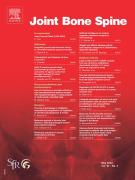Skeletal muscle mass and quality in gout patients versus non-gout controls: A computed tomography imaging study - 01/10/24
 , Michael Toprover a, b, 1, Cheongeun Oh c, Gregoire Leroy d, Ada Kumar e, Brian LaMoreaux e, Michael Mechlin f, Theodore R. Fields g, Michael H. Pillinger a, b, 2, Fabio Becce d, 2
, Michael Toprover a, b, 1, Cheongeun Oh c, Gregoire Leroy d, Ada Kumar e, Brian LaMoreaux e, Michael Mechlin f, Theodore R. Fields g, Michael H. Pillinger a, b, 2, Fabio Becce d, 2Graphical abstract |
Highlights |
• | Patients with gout have impaired muscle quality. |
• | Patients with gout may be at increased risk of sarcopenia. |
• | The importance of sarcopenia in rheumatic diseases is increasingly recognized. |
Abstract |
Objective |
Patients with gout are at elevated risk of multiple vascular and metabolic comorbidities. Whether they are also at risk of sarcopenia, which is known to affect patients with other rheumatic diseases, has not been previously assessed. We examined whether patients with gout have decreased lumbar muscle quality and quantity, indicating an association between gout and sarcopenia.
Methods |
Fifty gout subjects and 25 controls, ages 45–80, underwent computed tomography imaging of the lumbosacral spine. We measured muscle quantity (skeletal muscle area [SMA] and index [SMI]) and quality (skeletal muscle radiation attenuation [SMRA] and intermuscular adipose tissue [IMAT] area and index [IMATI]) of the psoas and erector spinae muscles at the L3 level.
Results |
Seventy subjects (45 gout and 25 controls) were included in the analysis. Gout subjects had higher BMI, more kidney disease and hypertension, lower exercise frequency, and higher mean serum urate and creatinine vs. controls. Lumbar SMRA was significantly lower in gout subjects vs. controls, indicating reduced muscle quality. Lumbar IMAT area was significantly higher in gout subjects vs. controls, as was lumbar IMATI, indicating increased muscle adiposity. These differences persisted after adjusting for potential confounders. In contrast, there was no significant difference between gout and control groups in lumbar SMA or lumbar SMI, suggesting that muscle quantity may not be routinely affected by the diagnosis of gout.
Conclusions |
Gout patients exhibit decreased lumbar muscle quality compared with controls, consistent with an association between gout and sarcopenia.
Le texte complet de cet article est disponible en PDF.Keywords : Gout, Sarcopenia, Muscle mass, Muscle quality, Lumbar spine, Dual-energy computed tomography
Plan
Vol 91 - N° 5
Article 105743- septembre 2024 Retour au numéroBienvenue sur EM-consulte, la référence des professionnels de santé.
L’accès au texte intégral de cet article nécessite un abonnement.
Déjà abonné à cette revue ?

